When someone faces a serious illness, the focus often centers on medical treatments—chemotherapy, radiation, surgery, or targeted therapies. While these interventions are essential, many individuals discover that healing encompasses more than just physical recovery. Emotional well-being, personal faith, and spiritual or existential connections can all play a crucial role in coping with the challenges ahead. By intentionally fostering strong emotional and spiritual support, people may feel more empowered and resilient as they navigate the complex journey toward remission. Below is an exploration of how to cultivate these supportive elements in everyday life.
Understanding Emotional and Spiritual Needs
Emotions run high when dealing with life-threatening conditions. Fear, uncertainty, anger, and sadness commonly surface. Some people try to suppress these feelings to stay “strong,” but unresolved emotions can increase stress and potentially hinder the healing process. In parallel, spiritual or faith-based questions—such as the purpose of suffering, the meaning of life, and the possibility of a higher power—may also emerge.
Addressing these concerns can be an integral part of healing. Emotional support and spiritual grounding often reduce anxiety, strengthen coping mechanisms, and foster a sense of hope. In practice, this might involve sharing fears with loved ones, seeking group support, or pursuing spiritual exercises that provide comfort and perspective.
The Role of Emotional Support
Emotional support serves as a safety net, offering understanding and compassion when individuals feel overwhelmed. It can come from diverse sources, including family, friends, professional counselors, or dedicated support groups. Regardless of the form, a strong emotional support system can bring several benefits:
- Stress Reduction: Talking through worries and frustrations helps lessen psychological pressure. Lower stress levels may, in turn, promote better sleep, improved appetite, and an enhanced immune response.
- Validation: Knowing that one’s feelings are acknowledged and accepted can alleviate loneliness. Feeling seen and heard by others often combats isolation, a common experience for those with chronic or severe illnesses.
- Practical Assistance: Emotional supporters frequently help in concrete ways—such as providing meals, offering rides to medical appointments, or helping organize medication schedules. This practical aid can make a complex journey more manageable.
- Perspective: Family, friends, or fellow patients might share stories, lessons, and coping techniques. Hearing others’ experiences can offer comfort, new ideas, and reassurance that one is not alone in the struggle.
By embracing emotional support, individuals often find a renewed sense of control, motivation, and hope—even during intense treatment phases.
Building a Trusted Network
Cultivating an emotional support system sometimes requires stepping out of one’s comfort zone. Different relationships serve varied roles; a spouse or best friend might offer daily companionship, whereas a support group provides deeper connections with people who share a similar diagnosis. Here are a few strategies for assembling a trusted network:
- Honest Communication: Clearly expressing one’s needs allows others to help more effectively. If someone needs regular check-ins or help with small tasks, articulating that can prevent misunderstanding and frustration.
- Diversifying Support: Relying on just one person can be overwhelming for both parties. Involving multiple friends or family members—each contributing in different ways—distributes responsibilities and creates a more stable support circle.
- Peer Support Groups: In-person or online communities designed for individuals facing the same condition can provide insights that others might not. Sharing personal stories, receiving practical tips, and voicing common fears can foster close bonds and relieve emotional burdens.
- Professional Help: Therapists or counselors trained in chronic illness or oncology-related concerns can guide patients through intense emotions, such as guilt or anger. They can also teach coping strategies and communication techniques to strengthen family dynamics.
As this network grows, it’s beneficial to maintain open dialogue and reassure those offering support that their involvement truly makes a difference.
Exploring the Spiritual Dimension
Beyond emotional assistance, many individuals find solace and strength in spirituality or faith, particularly when confronting life-altering illnesses. Spirituality can take many forms—ranging from formal religious practices to a simple sense of connection with nature or the universe. Even those who do not identify with a specific religion may experience what is sometimes called a “spiritual awakening” upon receiving a serious diagnosis. Some common spiritual practices or explorations include:
- Prayer or Reflection: Setting aside quiet time daily for prayer, meditation, or contemplative reading can cultivate inner peace and a feeling of connectedness. These moments provide a sense of grounding amidst medical uncertainties.
- Rituals and Ceremonies: Participating in organized events—such as worship services, candlelight vigils, or seasonal celebrations—can create a deeper sense of belonging and foster resilience through communal experience.
- Mindful Nature Walks: For those who feel connected to nature, gentle walks in parks, forests, or near bodies of water can be a spiritual experience. Observing natural beauty and cycles of renewal can inspire hope and remind individuals of life’s continuity.
- Journaling or Artistic Expression: Writing down personal reflections, drawing, or painting can help process intense feelings and reveal underlying spiritual or existential themes. This creative approach can nurture self-discovery and inner healing.
By weaving spiritual practices into daily life, people often find a renewed sense of purpose, which can buffer against despair and imbue medical treatments with deeper meaning.
Finding the Right Spiritual Community
Just as emotional support may come from diverse sources, spiritual reinforcement can be found through various communities. Some might resonate with a traditional faith institution—a local church, mosque, synagogue, or temple. Others might prefer less formal settings, such as mindfulness centers or nature retreats. Here are ways to explore these options:
- Visiting Different Congregations: If someone is unsure of their spiritual home, attending services or gatherings across denominations and philosophies can help them discern which environment feels most supportive.
- Online Faith Communities: For those who are housebound or uncomfortable with in-person gatherings, virtual groups and forums can offer spiritual guidance and fellowship. This route allows users to connect with others globally and participate in activities like collective prayer or meditation sessions via video conferencing.
- One-on-One Guidance: Spiritual leaders, chaplains, or mentors can provide individualized counsel, aiding individuals in navigating tough questions about life, suffering, and purpose. This type of guidance can be particularly comforting when coping with fear or uncertainty.
Finding a compatible spiritual community or mentor can help individuals cultivate hope, calmness, and a sense of belonging during a physically and emotionally demanding time.
Balancing Emotional and Spiritual Elements
While emotional and spiritual support can overlap, they each have unique roles. Emotional support offers reassurance, empathy, and practical help, directly addressing psychological needs. Spiritual support, on the other hand, speaks to deeper existential questions—identity, purpose, and the nature of life itself. Merging the two often proves mutually reinforcing. For example:
- Shared Practices: Engaging in group prayer, reflective reading, or communal meals can combine emotional bonding with spiritual nourishment. Such gatherings often deepen trust and understanding among participants.
- Counseling That Honors Spiritual Identity: Some therapists specialize in spiritually integrated counseling, acknowledging that religious or existential beliefs may significantly shape a person’s coping style. This type of counseling can help individuals align their emotional healing with their spiritual worldview.
- Meaningful Rituals: Activities like lighting a candle for someone in treatment, or creating a small altar with meaningful objects, can unify loved ones around a shared focus. This joint effort fosters emotional solidarity while tapping into spiritual symbolism.
Achieving balance involves attentiveness to both spheres. Individuals should remain open to adjusting this equilibrium as their needs evolve. During some stages of illness, emotional comfort might be paramount; at others, spiritual inquiry may take the foreground.
The Healing Power of Hope
One of the major outcomes of strong emotional and spiritual support is the emergence—or resurgence—of hope. Hope, in this context, does not imply denial of reality or blind optimism. Rather, it reflects a belief that life can still hold value, meaning, and joy despite difficult circumstances. This mindset can inspire individuals to follow through with treatments, adhere to lifestyle changes, and maintain better overall mental health.
At times, people might worry that fostering hope sets them up for disappointment if remission is not achieved. However, hope is often described as an active state of perseverance and possibility rather than a guarantee of specific outcomes. In fact, many cancer survivors emphasize that hope’s real power lies in allowing them to fully engage with each day, making purposeful choices and cherishing meaningful moments, regardless of the ultimate medical verdict.
Incorporating Ritual and Symbolism
Whether religious or secular, ritual and symbolism can anchor emotional and spiritual needs in tangible acts. A simple ritual might be lighting a candle each evening and reflecting on the day’s challenges and triumphs. Another could be writing a note of gratitude or fear and placing it in a container as a symbolic gesture of release.
Some families hold small ceremonies when their loved one completes a cycle of treatment, marking the occasion with words of affirmation, shared prayer, or expressions of gratitude. These ceremonial elements can help frame life’s transitions, imbuing them with a sense of purpose and acknowledgment rather than letting them pass unnoticed.
Overcoming Barriers and Misconceptions
Despite the potential benefits, some individuals hesitate to seek emotional or spiritual support. They may fear appearing weak, worry about imposing on others, or harbor negative past experiences with religious institutions. Overcoming these barriers often involves reframing one’s understanding:
- Acknowledging Normalcy: Struggling with fear or sadness during a health crisis is entirely natural, not a sign of personal failure. Sharing these emotions can, in fact, be a testament to strength and honesty.
- Choosing the Right Community: Not all spiritual or emotional support venues will resonate with everyone. It’s acceptable to explore multiple options and respectfully step away from any that feel uncomfortable or judgmental.
- Realizing Reciprocity: Providing emotional support is not solely a burden on others; it can also be a gift. Friends and family members often appreciate the opportunity to help and feel closer to their loved ones. Communities that offer spiritual guidance may likewise value the diversity of perspectives new members bring.
Addressing these misconceptions can pave the way for building a supportive environment that uplifts both the individual and those around them.
Practical Steps for Everyday Integration
Designate Quiet Time: Even five minutes of undisturbed reflection, prayer, or meditation daily can foster a deeper sense of calm. Setting a timer or doing this before bedtime ensures it becomes a regular habit.
Seek a Spiritual or Emotional Mentor: Whether it’s a counselor, a chaplain, or a trusted friend, identifying someone with whom to explore deeper emotional or existential questions can help clarify feelings and concerns.
Join or Form a Support Circle: If an existing support group doesn’t meet specific needs, consider forming a small circle with like-minded individuals. Meeting weekly—online or in person—can provide a safe space to share, reflect, and encourage one another.
Use Symbolic Reminders: Keeping a small object—like a stone, a piece of jewelry, or a meaningful photo—can serve as a tangible reminder of hope and resilience. It offers a focal point during moments of anxiety.
Track Emotional Ups and Downs: Maintaining a mood journal can help individuals recognize patterns. On tougher days, it can also serve as evidence that feelings evolve over time and that better moments often follow low points.
Practice Compassion and Forgiveness: Illness may bring regrets or resentments to the surface. Learning to forgive oneself or others can release emotional burdens, making room for healing to occur on multiple levels.
The Evolving Journey of Support
Emotional and spiritual support is rarely a static, one-time achievement; it evolves in response to changing circumstances. Early in the diagnostic phase, immediate emotional validation might take priority. During active treatment, practical help and faith-based routines can keep hope alive. Later, as the individual moves into remission or learns to manage a chronic condition, the focus might shift to sustaining the emotional and spiritual well-being that helped them endure the hardest moments.
Patients and families often discover that these supportive practices—once adopted out of necessity—become lifelong habits. Even after remission, the sense of connection, gratitude, and mindfulness cultivated during treatment can continue to enrich daily life.
Conclusion
For those seeking remission or learning to cope with a serious illness, cultivating strong emotional and spiritual support can be a defining aspect of the journey. Whether through trusted friends, professional counselors, community groups, or spiritual practices, these elements create a framework that promotes resilience, hope, and a renewed sense of purpose. While each person’s experience will differ, the core principles remain remarkably consistent: honest communication, accessible communities of care, and intentional moments of reflection or devotion.
Ultimately, building this support network is an act of self-compassion and empowerment. By recognizing the interwoven nature of emotional health, spiritual grounding, and physical well-being, individuals can nurture all dimensions of themselves. Although no single approach guarantees a specific outcome, embracing the depth and breadth of emotional and spiritual resources often transforms a challenging season into one characterized by growth, unity, and the possibility of a brighter tomorrow.


